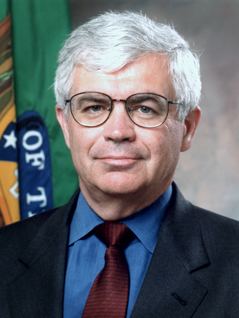 | ||
In economics, a Taylor rule is a reduced form approximation of the responsiveness of the nominal interest rate, as set by the central bank, to changes in inflation, output, or other economic conditions. In particular, the rule describes how, for each one-percent increase in inflation, the central bank tends to raise the nominal interest rate by more than one percentage point. This aspect of the rule is often called the Taylor principle. It should be noted that while such rules may serve as concise, descriptive proxies for central bank policy, and are not explicitly proscriptively considered by central banks when setting nominal rates.
Contents
- As an equation
- The Taylor principle
- Alternative versions of the rule
- Empirical relevance
- Criticisms
- References
The rule was first proposed by John B. Taylor, and simultaneously by Dale W. Henderson and Warwick McKibbin in 1993. It is intended to foster price stability and full employment by systematically reducing uncertainty and increasing the credibility of future actions by the central bank. It may also avoid the inefficiencies of time inconsistency from the exercise of discretionary policy. The Taylor rule synthesized, and provided a compromise between, competing schools of economics thought in a language devoid of rhetorical passion. Although many issues remain unresolved and views still differ about how the Taylor rule can best be applied in practice, research shows that the rule has advanced the practice of central banking.
As an equation
According to Taylor's original version of the rule, the nominal interest rate should respond to divergences of actual inflation rates from target inflation rates and of actual Gross Domestic Product (GDP) from potential GDP:
In this equation,
In this equation, both
The Taylor principle
By specifying
Alternative versions of the rule
While the Taylor principle has proved very influential, there is more debate about the other terms that should enter into the rule. According to some simple New Keynesian macroeconomic models, insofar as the central bank keeps inflation stable, the degree of fluctuation in output will be optimized (Blanchard and Gali call this property the 'divine coincidence'). In this case, the central bank does not need to take fluctuations in the output gap into account when setting interest rates (that is, it may optimally set
• Taylor Rule 1993 - the original definition by John Taylor with
• Taylor Rule 1999 - adapted and updated by John Taylor in a new research paper:
Empirical relevance
Although the Federal Reserve does not explicitly follow the Taylor rule, many analysts have argued that the rule provides a fairly accurate summary of US monetary policy under Paul Volcker and Alan Greenspan. Similar observations have been made about central banks in other developed economies, both in countries like Canada and New Zealand that have officially adopted inflation targeting rules, and in others like Germany where the Bundesbank's policy did not officially target the inflation rate. This observation has been cited by Clarida, Galí, and Gertler as a reason why inflation had remained under control and the economy had been relatively stable (the so-called 'Great Moderation') in most developed countries from the 1980s through the 2000s. However, according to Taylor, the rule was not followed in part of the 2000s, possibly leading to the housing bubble. Certain research has determined that some households form their expectations about the future path of interest rates, inflation, and unemployment in a way that is consistent with Taylor-type rules.
Criticisms
Athanasios Orphanides (2003) claims that the Taylor rule can misguide policy makers since they face real-time data. He shows that the Taylor rule matches the US funds rate less perfectly when accounting for these informational limitations and that an activist policy following the Taylor rule would have resulted in an inferior macroeconomic performance during the Great Inflation of the seventies.
In 2015, financial manager Bill Gross said the Taylor rule "must now be discarded into the trash bin of history", in light of tepid GDP growth in the years after 2009. Gross believed low interest rates were not the cure for decreased growth, but the source of the problem.
